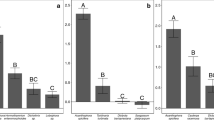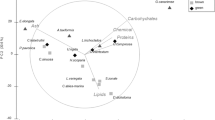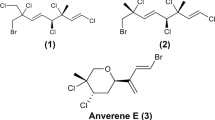Abstract
High levels of polyphloroglucinol phenolics in marine brown algae are usually interpreted as a defensive response to herbivory. However, tropical brown algae generally contain very low levels of phenolics, even though herbivory in many tropical systems (e.g. coral reefs) is intense. This apparent paradox would be explained if polyphenolics did not deter tropical herbivores, in which case selection by herbivores for high levels of phenolics in tropical algae would be weak. To examine this hypothesis, in February 1989 we presented mixed assemblages of herbivorous fishes on the Great Barrier Reef with tropical, phenolic-poor brown algae (primarilySargassum spp.) and closely related (conspecifics in one instance) phenolic-rich temperate species. Different species of brown algae were eaten at very different rates, but these differences were not correlated with variation in the phenolic levels among the plants. TLC and NMR analyses showed no evidence of other, non-polar, metabolites in these algae, with the exception of the temperate speciesHomoeostrichus sinclairii. Thus, variation in non-polar metabolites also did not explain the differences in susceptibility to herbivores among these algae. We conclude that the herbivorous fishes studied here were not deterred by phenolic-rich algae, which suggests that levels of phenolics in many tropical algae may generally be low due to their ineffectiveness as defences. However, alternative explanations for the pattern are possible, and these are discussed.
Similar content being viewed by others
Literature cited
Bakus, G. J., Green, G. (1974). Toxicity in sponges and holothurians: a geographic pattern. Science, N.Y. 185: 951–952
Bakus, G. J., Targett, N. M., Schulte, B. (1986). Chemical ecology of marine organisms: an overview. J. chem. Ecol. 12: 951–985
Bernays, E. A., Cooper-Driver G., Bilgener, M. (1989). Herbivores and plant tannins. Adv. ecol. Res. 19: 263–302
Brock, R. E. (1982). A critique of the visual census method for assessing coral reef populations. Bull. mar. Sci. 32: 269–276
Bryant, J., Chapin, III, F. S., Klein, D. R. (1983). Carbon/nutrient balance of boreal plants in relation to vertebrate herbivory. Oikos 40: 357–368
Carpenter, R. (1986). Partitioning herbivory and its effects on coral reef algal communities. Ecol. Monogr. 56: 345–363
Coley, P. D., Bryant, J. P., Chapin, F. S. (1985). Resource availability and plant antiherbivore defense. Science, N. Y. 230: 895–899
Coll, J. C., Bowden, B. F. (1986). The application of vacuum liquid chromatography to the separation of terpene mixtures. J. nat. Products (Lloydia) 49: 934–936
Day, R. W., Quinn, G. P. (1989). Comparisons of treatments after an analysis of variance in ecology. Ecol. Monogr. 59: 433–463
Denton, G. R. W., Burdon-Jones, C. (1986). Trace metals in waters of the Great Barrier Reef. Mar. Pollut. Bull. 17: 95–98
Estes, J. A., Steinberg, P. D. (1988). Predation, herbivory and kelp evolution. Paleobiology 14: 19–36
Faulkner, D. J. (1984). Marine natural products: metabolites of marine algae and herbivorous marine mollusks. Nat. Product. Rep. 1: 251–280
Faulkner, D. J. (1986). Marine natural products. Nat. Product. Rep. 3: 1–33
Fenical, W. (1980). Distributional and taxonomic features of toxinproducing marine algae. In: Abbott, I. A., Foster, M. S., Eklund, L. F. (eds.) Pacific seaweed aquaculture. California Sea Grant College Program, Institute of Marine Resources, University of California, La Jolla, California, USA, p. 144–151
Fowler, A. J. (1987). The development of sampling strategies for population studies of coral reef fishes. A case study. Coral Reefs 6: 49–58
Gaines, S. D., Lubchenco, J. (1982). A unified approach to marine plant-herbivore interactions. II. Biogeography. A. Rev. Ecol. Syst. 13: 111–138
Geiselman, J. A., McConnell, O. J. (1981). Polyphenols in the brown algaeFucus vesiculosus andAscophyllum nodosum: chemical defenses against the herbivorous snailLittorina littorea. J. chem. Ecol. 7: 1115–1133
Green, G. (1977). Ecology of toxicity in marine sponges. Mar. Biol. 40: 207–215
Hatcher, B. G., Larkum, A. W. D. (1983). An experimental analysis of factors controlling the standing crop of the epilithic algal community on a coral reef. J. exp. mar. Biol. Ecol. 69: 61–84
Hay, M. E. (1981). The functional morphology of turf-forming seaweeds: persistence in stressful marine habitats. Ecology 62: 739–750
Hay, M. E. (1984). Predictable spatial escapes from herbivory: how do these affect the evolution of herbivore resistance in tropical marine communities? Oecologia 64: 396–407
Hay, M. E. (1985). Spatial patterns of herbivore impact and their importance in maintaining algal species richness. Proc. 5th int. coral Reef Congr. 4: 29–34. [Gabrié, C. et al. (eds.) Antenne Museum-EPHE, Moorea, French Polynesia]
Hay, M. E., Duffy, J. E., Fenical, W., Gustafason, K. (1988). Chemical defense in the seaweedDictyopteris delicatula: differential effects against reef fishes and amphipods. Mar. Ecol. Prog. Ser. 48: 185–192
Hay, M. E., Fenical, W. (1988). Marine plant-herbivore interactions: the ecology of chemical defense. A. Rev. Syst. Ecol. 19: 111–145
Hay, M. E., Fenical, W., Gustafason, K. (1987). Chemical defense against diverse coral-reef herbivores. Ecology 68: 1581–1592
Horn, M. H. (1989). Biology of marine herbivorous fishes. Oceanogr. mar. Biol. A. Rev. 27: 167–272
Ilvessalo, H., Tuomi, J. (1989). Nutrient availability and accumulation of phenolic compounds in the brown algaFucus vesiculosus. Mar. Biol. 101: 115–119
Johnson, C. R., Mann, K. H. (1986). The importance of plant defense abilities to the structure of seaweed comunities: the kelpLaminaria longicruris de la Pylaie survives grazing by the snailLacuna vincta (Montagu) at high population densities. J. exp. mar. Biol. Ecol. 97: 231–267
Kato, T., Kumanireng, A. S., Ichinose, I., Kitihara, Y., Kakinada, Y., Kato, Y. (1975). Structure and synthesis of active component from a marine alga,Sargassum tortile, which inhibits the settling of swimming larvae ofCoryne uchidai. Chemy Lett. (Chem. Soc. Japan, Tokyo) 1975: 335–338
Lewis, S. M., Norris, J. N., Searles, R. B. (1987). The regulation of morphological plasticity by herbivory. Ecology 68: 636–641
Littler, M. M., Taylor, P. R., Littler, D. S. (1983). Algal resistance to herbivory on a Caribbean barrier reef. Coral Reefs 5: 63–71
Mayer, A. M., Harel, E. (1979). Polyphenol oxidases in plants. Phytochem. 18: 193–215
McClure, J. W. (1978). The physiology of phenolic compounds in plants. Recent Adv. Phytochem. 12: 525–556
Padilla, D. K. (1985). Structural resistance of algae to herbivores. A biomechanical approach. Mar. Biol. 90: 103–109
Paul, V. J., Fenical, W. (1987). Natural products chemistry and chemical defense in tropical marine algae of the phylum Chlorophyta. In: Scheuer, P. S. (ed.) Bioorganic marine chemistry. Springer-Verlag, Heidelberg, p. 1–29
Paul, V. J., Hay, M. E. (1986). Seaweed susceptibility to herbivory: chemical and morphological correlates. Mar. Ecol. Prog. Ser. 33: 255–264
Ragan, M. A., Glombitza, K.-W. (1986). Phlorotannins, brown algal polyphenols. Prog. phycol. Res. 4: 129–241
Ragan, M. A., Jensen, A. (1977). Quantitative studies on brown algal polyphenols. I. Estimation of absolute polyphenol-content ofAscophyllum nodosum (L.) andFucus vesiculosus (L.) J. exp. mar. Biol. Ecol. 34: 245–258
Renaud, P. E., Hay, M. E., Schmitt, T. (1990). Interactions of plant stress and herbivory: interspecific variation in the susceptibility of a palatable vs an unpalatable seaweed to sea urchin grazing. Oecologia 82: 217–226
Rhoades, D. (1979). Evolution of plant defenses against herbivory. In: Rosenthal, G. A., Janzen, D. H. (eds.) Herbivores. Academic Press, New York
Russ, G. (1984). Distribution and abundance of herbivorous grazing fishes in the central Great Barrier Reef. I. Levels of variability across the entire continental shelf. Mar. Ecol. Prog. Ser. 20: 23–34
Scott, F., Russ, G. (1987). Effects of grazing on species composition of the epilithic algal community on coral reefs of the Central Great Barrier Reef. Mar. Ecol. Prog. Ser. 39: 293–304
Shizuru, Y., Matsukawa, S., Ojika, M., Yamada, K. (1982). Two new farnesylacetone derivatives from the brown algaSargassum micracanthum. Phytochem. 21: 1808–1809
Steinberg, P. D. (1985). Feeding preferences ofTegula funebralis and chemical defenses in marine brown algae. Ecol. Monogr. 55: 333–349
Steinberg, P. D. (1986). Chemical defenses and the susceptibility of tropical marine algae to herbivores. Oecologia 69: 628–630
Steinberg, P. D. (1988). The effects of quantitative and qualitative variation in phenolic compounds on feeding in three species of marine invertebrate herbivores. J. exp. mar. Biol. Ecol. 120: 221–237
Steinberg, P. D. (1989). Biogeographical variation in brown algal polyphenolics and other secondary metabolites: comparison between temperate Australasia and North America. Oecologia 78: 373–382
Steinberg, P. D., Paul, V. J. (1990). Fish feeding and chemical defenses of tropical brown algae in Western Australia. Mar. Ecol. Prog. Ser. 58: 253–259
Steinberg, P. D., van Altena, I. A. (1991). Tolerance of marine invertebrate herbivores to brown algal phlorotannins in temperate Australasia. Ecol. Monogr. (in press)
Steneck, R. S. (1983). Escalating herbivory and resulting adaptive trends in calcareous algal crusts. Paleobiology 9: 44–61
Steneck, R. S. (1986). The ecology of coralline algal crusts: convergent patterns and adaptive strategies. A. Rev. Ecol. Syst. 17: 273–303
Swain, T., Hillis, W. E. (1959). The phenolic constituents ofPrunus domesticus. I. The quantitative analysis of phenolic constituents. J. Sci. Fd Agric. 10: 63–68
Targett, N. M., Targett, T. E., Vrolijk, N. H., Ogden, J. C. (1986). Effect of macrophyte secondary metabolites on feeding preferences of the herbivorous parrotfishSparisoma radians. Mar. Biol. 92: 141–148
Van Alstyne, K. L. (1988). Herbivore grazing increases polyphenolic defenses in the intertidal brown algaFucus distichus. Ecology 69: 655–663
Van Alstyne, K. L., Paul, V. J. The biogeography of polyphenolic compounds in marine macroalgae: temperate brown algal defenses deter feeding by tropical herbivorous fishes. Oecologia (in press)
Vermeij, G. J. (1978). Biogeography and adaptation. Harvard Press, Cambridge, Massachusetts, USA
Womersley, H. B. S. (1987). The marine benthic flora of South Australia. Part II. South Australian Government Printing Division, Adelaide, Southern Australia, Australia
Wylie, C. R., Paul, V. J. (1988). Feeding preferences of the surgeonfishZebrasoma flavascens in relation to chemical defenses of tropical algae. Mar. Ecol. Prog. Ser. 45: 23–32
Author information
Authors and Affiliations
Additional information
Communicated by G. F. Humphrey, Sydney
Rights and permissions
About this article
Cite this article
Steinberg, P.D., Edyvane, K., de Nys, R. et al. Lack of avoidance of phenolic-rich brown algae by tropical herbivorous fishes. Mar. Biol. 109, 335–343 (1991). https://doi.org/10.1007/BF01319401
Accepted:
Issue Date:
DOI: https://doi.org/10.1007/BF01319401




